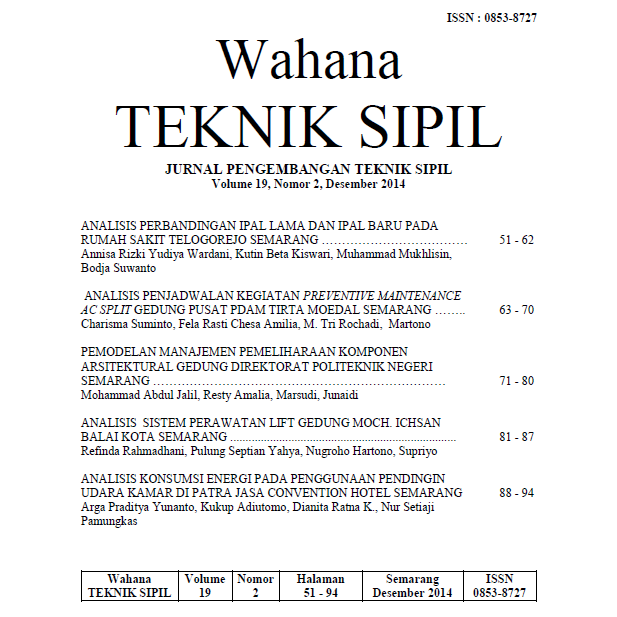Analisis Penjadwalan Kegiatan Preventive Maintenance Ac Split Gedung Pusat Pdam Tirta Moedal Semarang
DOI:
https://doi.org/10.32497/wahanats.v19i2.134Keywords:
scheduling, AC split, preventive maintenanceAbstract
The usage of air conditioner or air conditioner machine is a necessity for daily life. An office building, which has many rooms, needs more air conditioner (AC) as an attempt to fulfill comfort necessity to the rooms usage in the office building. By operating a large number of air conditioner, it requires a preventive maintenance system (preventive maintenance) that can give preventive act which is hoped being capable to keep the function and performance of the air conditioners functioning optimally. AC split preventive maintenance can be distinguished into 2 activities, they are small scale activity by cleaning the filter, the indoor part, the dust, etc, and then large scale preventive activity by doing complete cleaning to both outdoor and indoor components. At the building of PDAM Tirta Moedal Semarang, the preventive maintenance activities have had been undertaken by service provider vendor. All this time, the scheduling was not well-structured, so the activities which are undertaken by vendor are uncontrollable. To solve that problem, it needs analysis about the scheduling of preventive maintenance. Analysis is undertaken by looking for the tendency of treatment by classifying based on the capacity of the AC split. Based on this activity, it obtains the largest percentage treatment at interval 3 months, 1 pk (70.59%), and 2 pk (76.67%). These tendencies are used to arrange the new large scale preventive maintenance schedule, whereas the small scale scheduling is planned using literature study. The comparison of Budget Plan is used to compare between the result of the new scheduling and the earlier scheduling activity.
Downloads
Published
Issue
Section
License
Authors who publish with this journal agree to the following terms:Authors retain copyright and grant the journal right of first publication with the work simultaneously licensed under a Creative Commons Attribution License that allows others to share the work with an acknowledgement of the work's authorship and initial publication in this journal.
Authors are able to enter into separate, additional contractual arrangements for the non-exclusive distribution of the journal's published version of the work (e.g., post it to an institutional repository or publish it in a book), with an acknowledgement of its initial publication in this journal.
Authors are permitted and encouraged to post their work online (e.g., in institutional repositories or on their website) prior to and during the submission process, as it can lead to productive exchanges, as well as earlier and greater citation of published work (See The Effect of Open Access).






